35 East 100 North
Parowan, UT 84761
Phone: (435) 477-3331
By Steven D. Decker
Last Revised: 12 March 2024
Introduction
It is daunting, to be sure, to write a religious history of any community – particularly a small community. After all, politics and religion are the two untouchable subjects. Yet, one could ask, as a college professor once did, “What, of any importance, cannot be tied to politics or religion?”
Certainly Parowan, under some name, would have been settled without Mormon pioneers. There was water here, and farm land. There was iron ore nearby. Yet, without religion the history of Parowan would have undoubtedly unfolded differently. Therefore, this snippet of Parowan’s history looks at the dynamics of religion in the settlement and current religious life of Parowan. It does not make statements about doctrines, dogmas or philosophies, but looks at the historical establishment and growth of religion and some of the prominent figures in Parowan’s religious history.
Obviously, religion was a bulwark of the settlement of Utah in the 19th Century, Parowan included. This statement is made with some ease. While it is true that Mormon pioneers settled Utah, it is equally true that many non-Mormon religious folk came seeking toe-holds in “Mormondom.” Mormons came. They settled and expanded. Other religious groups came to establish congregations and schools, to convert, to proselytize, and perhaps to gather-up Mormon strays.
An example of this contest lies in a simple statement that suggested that the first Christian Sunday School held in Parowan was conducted by Presbyterian Minister William C. Cort on June 13, 1880, at the home of Daniel Page (Klein 16), who was by then a disaffected Mormon. The concept of not being included in the idea of a “Christian” Sunday School would, more than likely, have shocked the several hundred Mormon pioneers and settlers, members of the Church of Jesus Christ of Latter-day Saints, who lived in the community and who had actively participated in church services for nearly three decades. Mormons had been holding some form of Sunday School from the early days of the church. A church-wide general Sunday School was formed in the 1860s (Sunday School). Additionally, a local level of Sunday School is documented in Parowan as early as the 1850s, with Frances T. Whitney being called as the first Sunday School Superintendent (Third Ward History 13).
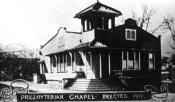
Yet, Presbyterian Elder Al Kline clarified the sentiment by forwarding four reasons why Presbyterians “were concerned” about Utah and the Mormons. According to Cline, Presbyterians:
Over the next several decades Presbyterians would suggest that “Missionary work in a Mormon community has little or no similarity to missionary work in an ordinary American community” (emphasis added), and that its “closest parallel perhaps would be to work amongst the Mohammedans” (Drury 289). They would report that, “Today [1924] the leaders of Mormonism are assuming a very militant attitude toward Christianity.” These attributes, Presbyterian workers felt, created a Mormon “wall of desolation” (Drury 290).
So missionaries and professors of religion came and went. Mormon missionaries left Parowan to proselyte. Other religious folk came to Parowan to proselyte.
Presbyterians focused heavily on establishing schools. This gave them a practical, though often tenuous, foothold in Mormon communities, and perhaps a chance to round up stray, disenfranchised and disaffected Mormons like Daniel Page and Jenkin and Sarah Evans.
Page was once an active Mormon. In 1859, he was listed as a counselor in a bishopric; in 1861, he was appointed to a committee to consider building a meeting house, to which he apparently contributed $50 (Dalton 300, 319, 321); by 1865, he welcomed Brigham Young’s party as “acting Bishop” of Parowan (Jensen 108). [Some light is shed on this matter by the Parowan Stake History thus: “Monday May 15, 1865 Bishop William Stockbridge Warren was set apart for a mission to Europe. He returned in 1867, and again resumed his duties as Bishop of Parowan. During his absence Counselor Page took temporary charge of the ward” (7)].
“Counselor Page” was excommunicated for subscribing to, “or, rather because I would not agree to abandon…” the decidedly anti-Mormon Salt Lake Tribune; by 1880 he was holding Presbyterian services in his home, and in 1886 he was implicated in the shooting of Edward Meeks Dalton, Mormonism’s (or at least Parowan’s) martyr for polygamy.
Other defectors had a less dramatic and less deadly story. The Evans’s, according to family lore, became disaffected when Sarah refused to pull her children from the Presbyterian school, which she considered the best educational opportunity in town. As tradition goes, the Evans children were taunted and called “Pressies” for attending the Presbyterians’ school. They, therefore, became Presbyterians (Evans Interview).
Klein writes: “A weak spot in Mormon domination [“domination” being a word that probably makes active Mormon’s flinch defensively] of their people was the education of children, since there were no public schools and the private schools had poorly trained teachers. Protestants made education central to their mission in Utah” (Klein 11).
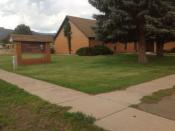
The combining of religious and temporal goals is not unique to a particular denomination. Religious people of all faiths desire education and they have to make a living. They insert themselves into both the religious and the work-a-day world. Presbyterians did it in the 1880s, to some extent, with education. The Grace Christian Church did it in the 1960s with bees.
Brigham Young named Utah and surrounding areas “Deseret” (the State or Territory of Deseret). The term, Deseret, comes from the Book of Mormon and signifies honey bee. “And they did carry with them Deseret, which, by interpretation, is a honey bee” (Book of Mormon, Ether 2:3). The beehive, a symbol of industry, has been adopted as the Utah State Emblem; the honey bee is the Utah State Insect; the State Astronomical Symbol is the Beehive Cluster located in the constellation Cancer the Crab (“Utah State Symbols”).
Industry must have been a watchword to wrest and domesticate Utah’s desert. Interesting it is that it was the bee business brought the founders of Grace Christian Church to Parowan.
In 1966, John Cowan owned a bee operation in Brawley, California, where he pastored a non-denominational, evangelical Christian church – The Assembly of Jesus Christ. It was then that John and his wife, Wilena, decided to relocate to Parowan.
Along with the Cowens came Bill and Norma (the Cowens’ daughter) Holiman, David (the Cowens’son) and Tami Cowen, and Art and Jewell Northington and their families. At first the families met for worship in their homes, but later rented the small building at 20 East 100 North. John soon purchased an old chicken coop at 133 East 300 South as a warehouse for his bee operation. In time the upper level was renovated into a place of worship. There the congregation worshiped and grew while the bee business grew on the ground level.
The Parowan Christian School was started and lasted two decades. This K-12 school participated in state and national competitions with other Christian schools and boasts many graduates.
With the Assembly of Jesus Christ came the Parowan Camp Meetings. These now abandoned events were held annually near the 4th of July. Camp meetings began in 1968, when a missionary visited the congregation and set up a tent across the street (south) from the church building. In the years to follow the Parowan Camp Meeting rallied evangelicals from all across the United States as well as Mexico and Canada. Finally, a church in Salt Lake City donated a tent that would hold the swelling numbers of camp meeting attendees – some 500 or 600 people. The city park and the Second Left Hand (in Parowan Canyon) were sites of gathering, preaching, praising and friendship.
It did not always go well, however. “One year a forceful wind came down the canyon and destroyed the tent so the camp meeting was moved to the Iron County Fair Building. It was held there for several years. The friendships that were formed, the encouragement received still revives fond memories among those who attended.” From a brief history provided by Grace Christian Church, the present name of the church that began as the Assembly of Jesus Christ, the record continues, “Many look back to those inspiring meetings under the tent, out in nature where you could see the hand of God and feel His presence as life changing.”
The Church was pastored by John Cowen from 1966 until 1987 when John “felt that he had completed the work he was called to do…” and his son, Dan, a graduate of International Bible College, San Antonio, Texas, became Pastor. During John’s ministry the Church grew and so did the need for property. A new church was built in 1977, in the present location of Grace Christian Church (845 West 200 South). During the Church’s ministry, the church building has been expanded and a nearby home acquired to accommodate the physical needs of the congregation.
Rob Bernhardi, Dan’s son-in-law and also a graduate of International Bible College, became Assocate Pastor in 1994. He, with his wife, Jana, have worked to involve the congregation’s youth in the performing arts. Christmas plays and various programs have been performed at Parowan’s Aladdin Theater and at various church venues in Southern Utah. In its healthy and robust tenure as a part of Parowan’s religious landscape, the Church has hosted gospel artists and national and international missionaries.
The name of the Church was changed in 2005 from The Assembly of Jesus Christ to Grace Christian Church “which more correctly defines who we are as a church. Indeed, Grace Christian Church sees their history as “His-story – about Christ’s love for mankind. That is what we as a congregation hope will be seen in us – Christ’s love.”
At the time of this writing (2013), Grace Christian Church boasts an attendance of 100-125 parishioners a week.
There is an interesting substory to Grace Christian Church. That is, the bee operation they came to Parowan to begin continues as one of the longest continuously running commercial operations in Parowan. Known now as Cowen Manufacturing the reins have been passed from John Cowen to Dave who, in time, brought his sons, Joshua and Nathan, into the business. Though the bees are gone, the business is international in scope and ships honey manufacturing equipment to major markets in the United States and Canada, as well as Sweden, Israel, Argentina, France, Australia, Mexico and Chile (“Cowan Manufacturing”).
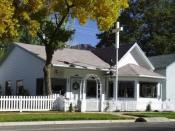
Perhaps we see something of an evolution of tolerance among the statements of acceptance, or the lack there of, between religious entities of Parowan. That is, while the Presbyterians were concerned with the Mormons’ “militant attitude toward Christianity,” we find the Grace Christian Church’s brief written history, submitted to assist in the compilation of this history, silent on the matter of their reception in Parowan. Though in conversation, one Grace Christian representative characterized their reception as “reserved.”
Yet, the Parowan United Methodist Church, has gleefully reported that their “Congregation was graciously welcomed by Leaders and Members of The Assembly of Jesus Christ [now Grace Christian], The Church of Jesus Christ of Latter Day Saints, Red Hills Southern Baptist Church and other Iron County Congregations.” Indeed, “Gifts of furnishings have been received with appreciation” (United Methodist Church, Parowan). Among these gifts given to the Parowan United Methodist Church were pews from the, then, newly remodeled Parowan Stake Center of the Church of Jesus Christ of Latter-day Saints.
Dr. Douglas A. (1925-2009) and Reverend Jeri Lee Harrell bought property in Parowan in 1988. On July 2, 2000 they founded Parowan United Methodist Church, which they would Co-Pastor. The Church uses, or has had used in its behalf, the terms: spiritual, friendly, warm hearted, resolutely missional, ecumenical and inclusive. Indeed, the Church’s motto is: Open hearts. Open minds. Open doors (United Methodist Church, Parowan).
The building that houses Parowan UMC is a remodeled restaurant. Though the building has been through several iterations of cafes or restaurants in its lifetime, it has, for over a decade, served more spiritual appetites.
Prior to moving to Parowan Reverend Jeri Lee Harrell (now Jeri Lee Harrell-Leeper) was Pastor of Advent United Methodist Church, Las Vegas, Nevada and, prior to that, of Pahrump Valley United Methodist Church, Nevada. She studied at Claremont Theological Seminary, California, and at Wesley Theological Seminary, Washington, DC. She was ordained in 1991 by Bishop Elias Galvis, the first Hispanic to be ordained a Methodist Bishop.
Because of Jeri Lee’s work with the United Methodist Women’s organization she is privileged to have a scholarship offered in her name by Red Bird Missionary Conference, Beverly, Kentucky. The endowed scholarship fund currently exceeds $14,000.
The late Douglas Harrell was a retired Air Force Colonel (Chaplain) and Pastored in Florida, Alaska, Oregon, California, Nevada and Utah. He was a Freemason and the Founding Pastor of several congregations (United Methodist Church, Parowan). He received his license to preach in 1942 at the age of seventeen. He was unpaid for his ministry in Parowan. He was already receiving pension from the Church as well as from his 28 year career in the USAF.
The Parowan United Methodist Church’s membership has been as high as sixty parishioners and has had as many as 40 attendees each week. As testament to interfaith relations, and in the absence of accomplished organists among the current congregation of Methodists, it has been the Church of Jesus Christ of Latter-day Saints that furnished organists for Methodist worship services – Jay Wilcken, Donnett Vincent, and most recently, former Mormon Tabernacle Choir member, Jackie Robinson (Harrell-Leeper).
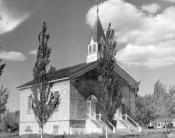
With all this, it is the Church of Jesus Christ of Latter-day Saints that has the longest and, if counted by membership, the largest religious impact on Parowan since its settlement. The Parowan “Stake” consists of seven local “wards” or congregations – five in Parowan and one each in Paragonah and Summit. (The term “stake” is taken from Isaiah 54:2: “Enlarge the place of thy tent…lengthen thy cords, and strengthen thy stakes).”
Parowan has adopted the uniquely fitting and appropriate moniker of “Mother Town of Southern Utah.” Indeed, during the winter of 1850-51, “120 men all in the prime of youth and vigor, thirty women over fourteen years of age and eighteen children under fourteen” (Dalton, 16) gathered and came to the Valley of the Little Salt Lake, and they came to stay. With them they brought “101 wagons, 2 carriages, 100 horses, 12 mules, 368 oxen, 146 cows and 166 head of loose cattle” along with seeds, foodstuffs, tools, plows, guns, swords ammunition, a cannon, “14 dogs, 18 cats, 121 chickens” (Dalton 18). They arrived January 13, 1851. From Parowan, dozens of other communities have been founded.
Within three days, a local government was formed complete with justices, a sheriff, recorder, assessor and collector, roads supervisor, magistrates and constables. Local ecclesiastical units were formed on February 9th (Dalton 27-28, 35).
However, it would be folly to assume that the settlement of Parowan was by any means other than under ecclesiastical authority. Church President Brigham Young called missionaries to settle the valley. It had been previously scouted by Apostle Parley P. Pratt. The mission was led by Apostle George A. Smith (Bagley).
Concerned for their safety, the settlers, or “saints” as they are often referred to, allowed for protective measures by erecting a fort, then expanding it (for brief information about the forts see:https://www.parowan.org/index.php/heritage/comprehensive-history/1030-forts.html). They also began a two-pronged mission of survival: (1) Build religion, and (2) build community and industry. The 168 people who came would need to survive, provide for their safety, and prepare for others who would come.
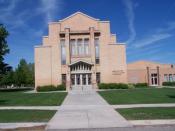
Local ecclesiastical leadership was firmly established. Homes, practical buildings (storehouses, assembly halls), and places of worship and entertainment were erected. Factories and business enterprises were quickly established. They had come to settle, to stay. (An article or “chapter” on the industrial history will be added at a later date).
In the settlement of Parowan, Mormon pioneers looked to the sacred as well as the temporal and physical. Immediately preparations were made to protect the pioneer settlers. Remembering that the pioneers arrived here on January 13, 1851, note the following chain of events that are taken from History of the Parowan Third Ward, 1851-1981 (13-54), local signage or monuments, and other cited sources, commemorating the following events: civil elections were held within three days; school began on February 25th in the home of George A. Smith; a log school house (18 x 24 ft.) and a Council House (22 x 45 ft.), housing religious and social needs, were dedicated before the close of 1851 (the school house was dedicated on Christmas Day); a Bishop’s Storehouse (a place of gathering and dispersing foodstuffs, clothing, and the like to those in need) was completed in 1855; a more permanent rock church was built from 1863-1867 with room for worship upstairs and room for school and social activities in the basement (use of this building ceased by 1918); a social hall/comedy house was completed in 1870 and replaced by a brick Opera House in 1897.
The Parowan Ward Church (currently the Stake Center on Main Street) was dedicated in 1918. This building has been through several major renovations, 1950, 1958-59. New ward and stake offices, a new relief society room and high council area were added in 2000.
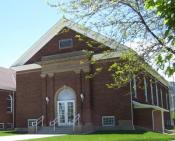
In 1928 the West Ward, or the 1st/2nd Ward, building was ready for use. It stood on the Corner of100 West and Center Street. Much of the material for this building was taken from the old Opera House, which was torn down. The 1928 building went through several renovations to accommodate modern times and growing congregations. Classrooms, a baptismal font, and bishops offices were added in the 1970s. Refurbishing of the interior was accomplished in 1999. Finally, however, the building was razed in 2013 to make way for the new 1st/2nd/5th Ward building (anticipated dedication September 2013).
The first seminary building, a venue for religious education of high school-aged public school students, was built in 1937 and, after the debt was cleared, dedicated in 1940 by Apostle John A. Widtsoe (Parowan Times 1940-03-29). A contract for a new seminary building, very near the old one at about 200 North and Main Street, was awarded in 1970. This building was used as a seminary until the 1994, after which it was used by Parowan High School until it was razed in 2013. A two-classroom seminary at 295 North Main Street, has been in use since midway through the 1993-94 school year.
A Welfare Cannery, housed in the Bishop’s Storehouse, was funded by the East, West, and Paragonah Wards in 1942. Many long-time residents remember working in this cannery.
The Parowan Stake, originally having had a huge geographical footprint, has been shrinking geographically since its inception. This is because, as the church has grown, new stakes have been created to accommodate the needs of growing membership, thus splitting off from the parent stake. These sort of splits can be seen on several occasions, but examples include the 1948 division when the Parowan Stake that stretched from Kanarraville to Paragonah, and west to New Castle (“Parowan Stake, Utah LDS Wards and Branches”) was divided to include only Enoch, Summit, Parowan and Paragonah. A subsequent division, 1978, removed Enoch from the Stake. Parowan was divided into three wards December 31, 1950, four wards in 1980 (Benson), and five wards in 2012.
The Church currently conducts a worship service (Sacrament Meeting) in Brian Head. There is no formal unit of the Church organized in Brian Head, though a branch was organized in 1976 with Carlisle P. Gurr as the first Branch President. Gurr was followed by Parowan High School teacher and coach, W. Ralph Riggs.
Similar growth and the need for church buildings can be documented in Summit and Paragonah. The first church house in Summit was begun in 1911. Prior to this time, church services were held in a log school house and, later, in a concrete school/church. Money for a “real church” was raised, at least in part, by gathering and selling the eggs from the community that were laid on Sunday. This two-storey church housed a chapel and two clasrooms on the ground floor, and an open recreation room, complete with stage, on the upper level. The church appears to have been completed in or shortly after 1916. It served its purpose for over three decades and was razed in 1948 (History of Summit).
In 1949 a chapel was dedicated in Summit by LeGrande Richards, the Presiding Bishop of the Church, later to become an Apostle (Iron County Record, 1949-04-21, 1949-04-28). The Summit Ward building again underwent a major overhaul in the mid-1980s.
Iterations of buildings began in Paragonah by 1861. Prior to that, congregations met in homes or traveled to Parowan. The 1861 building was made of local adobe and whitewashed. It was referred to as “the Old White Church” and measured only 24 x 34 feet. Another building was begun in 1884, but was never completed because of financial difficulties and persecution over the practice of polygamy, so the Old White Church was remodeled in 1890.
In 1900 the Paragonah Tabernacle was erected, to which a Cultural Hall was later added. In time, 1974, a groundbreaking ceremony was held for the current church. The Tabernacle was torn down and the new church was dedicated in 1976, by Elder Marion D. Hanks. Renovation again occurred in 1986, when the south wing was added (“A Memory Bank for Paragonah 17-38).
As the local Church grew in numbers and as members of the Church of Jesus Christ of Latter-day Saints grew faith and desire to serve, hundreds of missionaries were and are being sent all over the world. A complete list of missionaries sent from the Parowan Stake may not be achievable, but as comprehensive of a list as is possible is being built.
Others
There have been others who have worked to serve the religions needs of Parowan and her citizens, whether or not formal congregations have been established. The Catholics have, intermittently, held services in Parowan. Repeated attempts to gather information from the local Catholic church have gone unanswered. If information becomes available it will be added.
There is a Baptist storefront in town, the Parowan Baptist Church, though it is not, at this time, believed that a congregation is established or meets regularly. Again, if information becomes available it will be added to this history.
Conclusion
Nothing herein speaks of the “spirituality” of the churches or the people of Parowan. No history can do that. The membership of each church will say they attend because of the spirituality that they feel in that church. If religious success can be measured by religious growth, then certainly religion in Parowan has been a success.
Some residents, of course, attend no church, though they may claim membership within a church. In this respect, Parowan is no different than other communities.
Others will identify with a concept of spirituality rather than organized religion. The suggestion that, “I am a spiritual person, but not a religious one,” is not disputed herein. It cannot be. But neither can it be measured and documented and, therefore, rests outside the scope of this history.
Obviously, there are those to whom religion and/or spirituality are very important, and others to whom they mean little. Perhaps all readers of this history will find interest in the history, according to their own interests and desires.
APPENDIX: Religious Leadership (Stake Presidents, Bishops, Pastors and Reverends (churches listed alphabetically)
Church of Jesus Christ of Latter-day Saints Leadership in Parowan Stake
● Stake Presidents
John Calvin Lazell Smith, 1852-1856 (Dalton, 305-06)
William H. Dame, 1856-1881 (Dalton, 305-06)
Thomas J. Jones, 1881-1892 (Dalton, 305-06)
Uriah T. Jones, 1892-1909 (Dalton, 305-06, Iron County Record, 1909-09-24)
Lucius N. Marsden, 1909-1916 (Parowan Times, 1916-09-27)
Wilford Day, 1916-1919 (Iron County Record, 1919-12-26)
Henry W. Lunt, 1919-1925 (Iron County Record, 1925-06-05)
William R. Palmer, 1925-1940 (Iron County Record, 1940-11-14)
David LeRoy Sargent, 1940-1948, Stake Split (Iron County Record, 1948-05-06)
W. Clair Rowley, 1948-1955 (Dalton, 305-06)
Howard D. Knight, 1955-1972 (Stake History, 162-63;)
J. Phillip Hanks, 1972- 1982 (Stake History, 163;)
Kent C. Wilson, 1982-1991 (Iron County Record, 1982-03-25)
Ronald K. Smith, 1991-2001 (http://www.ldschurchnews.com/articles/20898/New-stake-presidencies.html
Douglas G. Vincent, 2001-2010 (http://www.ldschurchnews.com/articles/40033/New-stake-presidencies.html
David P. Hamilton, 2010- 2019 (http://www.ldschurchnews.com/articles/59515/New-stake-presidents.html
Gale, Wade, 2019-
The following information, down to “Bishops – Paragonah” was extracted from History of Parowan Third Ward, 1851-1981, signified by an asterisk (*), or living memory of those involved, unless otherwise cited.
● Wards – Settlement (3rd Ward History)
George A. Smith – President of the Parowan Mission, 1851*
Anson Call, Bishop 1st Ward, 1851-1852*
Tarleton Lewis, Bishop 2nd Ward, 1851-1852*
Daniel A. Miller, Bishop 3rd Ward, 1851-1852*
Joseph L. Robinson, Bishop 4th Ward, 1851-1852*
● Four Wards Collapsed Into One
Tarleton Lewis, 1856-1859*
William S. Warren, 1859-1869 (Daniel Page, 1st Counselor, presided while Warren served a mission in Europe, 1865-1867).*
● Two Wards Created
Herman D. Bayles, 1st Ward, 1869-1880*
William C. Mitchell, 1st Ward, 1880-1885*
Samuel Rogers, 2nd Ward, 1869-1885*
● Two Wards, Again, Collapsed Into One
Charles Adams, 1885-1901*
Morgan Richards, 1901-1909*
Walter C. Mitchell, 1909-1913*
James L. Adams, 1913-1916*
Hans J. Mortensen, 1916-1921*
Hugh L. Adams, 1921-1926 (Continues as Bishop of the West Ward, Iron County Record, 1926-03-19)*
● Wards Divided into East and West
L. Nelson Marsden (East), 1926-1929*
J. Clayton Mitchell (East), 1929-1932*
William L. Adams (East), 1932-1942*
Jess W. Guymon, (East) 1942-1948*
Karl O. Mitchell, 1948-1951 (East Ward, continues as Bishop of 3rd Ward)*
Hugh L. Adams (West), 1926-1937
Thomas Wendell Bayles (West), 1937-1943 (Parowan Times 1937-11-19; Parowan Times, 1943-09-03)
W. Scott Day (West), 1943-1945 (Parowan Times, 1945-10-19)
W. Leonard Evans, (West), (1945)-1951 (Iron County Record, 1951-01-04)
● Bishops – Paragonah (for information on Bishops 1853-1988 see A Memory Bank for Paragonah, 1851-1990)
William H. Dame, Presiding Elder, 1853
Orson B. Adams, Presiding Elder, 1855 (re-establishment) – 1869
Silas S. Smith, 1869-1877
William E. Jones, Presiding Priest, 1877-1879
Erastus E. McIntire, 1879-1882
William E. Jones, 1882-1897
Stephen S. Barton, 1897-1908
Thomas W. Jones, 1908-1931
Kenyon Doyle Robinson, 1931- 1941
Gilbert Robinson, 1947- 1953
Victor R. Robinson, 1953-1960
James H. Anderson, 1960-1962
G. Boyd Robinson, 1962-1969
Myron W. Abbott, 1969-1975
Kenneth G. Topham, 1975-1978
Clark A. Lamoreaux, 1978-1982
Ralph A. Lister, 1982-1988
G. Boyd Robinson, 1988-1991
Albin Judd, 1991-1996
Donald Hulet, 1996-2001
Roger Kay Lister, 2001-2006
Richard A. Little, 2006-2011
Wayne F. Rowley, 2011-2016
J. Royce Barton, 2016-2022
Ted Cooke, 2022 -
● Bishops – First Ward
D. Watson Adams, 1951-1954 (Iron County Record, 1951-01-04; Stake History 162)
Howard Knight, 1954-1955 (Iron County Record, 1955-11-17)
R. Taylor Miller, 1955-1958 (Iron County Record, 1955-12-15; Church History Department e-mail)
Harley Warren Dalton, 1958-1961 (Church History Department e-mail)
Bruce DeW. Matheson, 1961-1969 (Church History Department e-mail)
Budd Munford, 1969-1971 (Iron County Record, 1971-03-04; Church History Department e-mail)
Stephen R. Adams, 1971-1976
Ronald K. Smith, 1976-1981
David I. Yardley, 1981-1985
Alma L. Adams, 1985-1991
Ronald A. Larsen, 1991-1995
Douglas G. Vincent, 1995-2000
Steven D. Decker, 2000-2006
David K. Pace, 2006-2012
Gary L. Overson, 2012-2017
Jeffrey P. Wood, 2017-2023
Matthew Gale, 2023 -
● Bishop – Second Ward
Claude W. Adams, 1951-(1955) (Iron County Record, 1951-01-04)
George Rowley, (1955)-1960
Gordon Farnsworth, 1960-1963 (Iron County Recored, 1963-10-31)
Rupert Hulet, 1963-(1971)
Richard Wilson Dotson, (1971)-1972 (Church History Department e-mail)
Ernest Ahlborn, 1972-1975
Rodney Adams, 1975-1976
Glen Halterman, 1976-1982
Lamar Jensen, 1982-1986
Burton, Rex D., 1986-1991
Hamilton, David P., 1991-1996
James H. Rasmussen, 1996-2001
Jerry D. Robinson, 2001-2006
Tom Zaleski, 2006-2012
Trever Anderson, 2012-2018
Michael Crocket, 2018-2023
Michael D. Robinson, 2023-
● Bishops – Third Ward (From History of Parowan Third Ward)
Karl O. Mitchell, 1951-1954*
Howard M. Adams, 1954-1961*
Charles H. Gurr, 1961-1963*
Verl E. Taylor, 1963-1970*
Val Hyatt Bentley, 1970-1973*
Boyd L. Mitchell, 1973-1977*
Reginald L. Hughes, 1977-1981*
Reed L. Orton, 1981*-1986
Carlisle Gurr, 1986-1991
Dennis Lowder, 1991-1996
James C. Robinson, 1996-2001
Scott Munson, 2001-2006
J. Philip Eves, 2006-2011
Bryce K. Haderlie, 2011-2013
Roy D. Mathews, 2013-2018.
David Mineer, Jr., 2018-2024
Angelo Biasi, 2024-
● Bishops – Fourth Ward
Kent C. Wilson, 1980-1982
Alan Adams, 1982-1987
Charles Cunningham, 1987-1992
Kent C. Wilson, 1992-1997
Gene Carter, 1997-2001
James G. Guymon, 2001-2007
John Ruesch, 2007-2013
Michael R. Adams, 2013-2019
Jared Meibos, 2019 –2024
Cody Wilson, 2024
● Bishops – Fifth Ward
Mark C. Evans, 2012-2017
Cheston Massey, 2017-2022
J. Kyle Johnson, 2022-
● Bishops - 6th Ward
Benjamin A. Johnson, 2023
● Bishops – Summit (Provided by plaque on wall near Bishop’s office)
Presiding Elders listed as William Dalley, 1860-1871; Edward Davis, 1871-1873; Sylvanus Cyrus Hulet, 1873-1877 (History of Summit).
Sylvanus Cyrus Hulet, 1877-1885
Sylvester Silas Hulet, 1885-1888
Joseph B. Dalley, 1888-1905
Oscar Willard Hulet, 1905-1906
Charles R. Dalley, 1906-1916
John H. Dalley, 1916-1930
Oscar J. Hulet, 1930-1934
Otto P. Dalley, 1934-1943
Raymond Lee Farrow, 1943-1952
Lyle B. Farrow, 1952-1957
H. Ivan Dalley, 1957-1967
Delos R. Dalton, 1967-1973
J. Frank Dalley, 1973-1978
Kenneth O. Rowley, 1978-1984
Dannie L. Condie, 1984-1986
Alma C. Lawrence, 1986-1992
Fred L. Whicker, 1992-1997
DeeEl Stapley, 1997-2002
Val Dean Williams, 2002-2007
Wade Gale, 2007-2014
Darin Lauritzen, 2014-2019
Clifford Dalton Stubbs, 2019-
Grace Christian Church Leadership in Parowan
● John Cowen, Pastor, 1966-1987
● Dan Cowan, Pastor, 1987-2018
● Rob Bernhardi, Associate Pastor, 1994-2018
● Rob Bernhardi, Pastor, 2018-
● Dan Cowan, Associate Pastor, 2018-
Presbyterian Leadership in Parowan (Burton)
● W. C. Cort, 1880-1884.
● Philip D. Stoops, 1885-1888 & 1890.
● T. L. Leverett, 1894-1897.
● E. M. Landis, 1905-1906.
● Claton S. Rice, 1913-1918.
● Paul E. Davies, 1924
● Elmer P. Dieser, 1925-1927.
● A. W. Bartholomew, 1927-1929.
● William Macrae Forsythe, 1930-1938.
United Methodist Church Leadership in Parowan
● Dr. Douglas Harrell, 2000-2009.
● Reverend Jeri Lee Harrell-Leeper, 2000-2022.
Notes
A Memory Bank for Paragonah. Community Press, Provo, UT. Betsy Topham Camp, Daughters of Utah Pioneers, 1990. Print.
Bagley, Will. “Parowan Settled By Mormons 150 Years Ago.” Utah History To Go. Salt Lake Tribune, 13 Jan 2001. Web. 11 Jun 2013. <http://historytogo.utah.gov/salt_lake_tribune/history_matters/011301.html>.
Benson, Richard M., (compiler), History of the Parowan Third Ward, 1851-1981.
Burton, Fred. “Presbyterians in Parowan.” Message to Steven D. Decker. 20 Dec 2008. E-mail.
Cowen, Sharon, (document delivered by). [History of Grace Christian Church]. Print
Cowan Manuracturing Co. Inc. Cowan Manufacturing Co. Inc. Web. 29 Apr. 2013.
Dalley, H. Ivan and Howard H. Dalley, History of Summit, 1967. Print.
Dalton, Luella Adams. History of Iron County Mission and Parowan the Mother Town, 5th ed. (Daughters of Utah Pioneers, Parowan Old Rock Church Museum, 2001).
Drury, Clifford Merrill. Presbyterian Panorama: One Hundred and Fifty Years of National Missions History. Philadelphia: Board of Christian Education, Presbyterian Church in the United States of America, 1952. Print.
Evans, Mark C. and Joyce B. Personal Interview.
[Grace Christian Church History]. Delivered by Sharon Cowan, n.d.
Harrell, Leeper, Jeri Lee. Personal Interview. 2013.
Parowan United Methodist Church, 15 Dec 2010. Web. 26 Sep 2012. <http://parowanumc.org/index.php?option=com_content&view=category&layout=blog&id=34&Itemid=53>.
Jensen, Andrew. History of the Parowan Ward, [held at the Parowan City Library].
Klein, Al, and Charles Jeffrey Garrison. A Report of the History of Community Presbyterian Church Cedar City, Utah. Held at Cedar City, Utah Public Library Special Collections (loose-leaf binder), 2000. Print.
“New Stake Created – 5 New Bishoprics.” Iron County Record, 23 Mar. 1978.
Page, Daniel. “The Case of Daniel Page.” Salt Lake Tribune [Salt Lake City] 16 Jan 1887, 4. Web. 26 Sep. 2012.
“Parowan Stake, Utah LDS Wards and Branches.” FamilySearch. The Church of Jesus Christ of Latter-day Saints. 10 Apr 2013. Web. 11 Jun 2013. <https://familysearch.org/learn/wiki/en/Parowan_Stake,_Utah_LDS_Church_Wards_and_Branches.>
“Sunday School (LDS Church).” Wikipedia. N.p., 08 Sep 2012. Web. 24 Sep 2012.
“The People of the United Methodist Church, Parowan, Utah.” Parowan United Methodist Church. Parowan United Methodist Church, 2011. Web. 11 Jun 2013. <http://parowanumc.org/>
Topham, Kenneth, (compiler), Parowan, Utah Stake History, 1851-1980.
“Utah State Symbols.” State of Utah. Web. 11 Jun 2013. <http://www.utah.gov/about/symbols.html>
Photo Credits:
Church of Jesus Chrsit of Latter-day Saints, Rock Church, Southern Utah University, Gerald R. Sherratt Library, Special Collections/Archives
Church of Jesus Christ of Latter-day Saints, Stake Center, Jerry Bixman
Church of Jesus Christ of Latter-day Saints, West Ward (1st/2nd Ward), Jerry Bixman
Parowan United Methodist Church, Jerry Bixman
Presbyterian Chapel, Southern Utah University, Gerald R. Sherratt Library, Special Collections/Archives